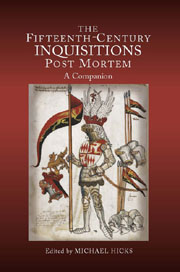Book contents
- Frontmatter
- Contents
- List of Tables and Figures
- List of Contributors
- Preface
- Glossary
- Abbreviations
- 1 Introduction
- 2 Crossing Generations: Dower, Jointure and Courtesy
- 3 The Lesser Landowners and the Inquisitions Post Mortem
- 4 Tales of Idiots, Signifying Something: Evidence of Process in the Inquisitions Post Mortem
- 5 The Value of Fifteenth-Century Inquisitions Post Mortem for Economic and Social History
- 6 ‘Notoriously Unreliable’: The Valuations and Extents
- 7 The Descriptions of Land Found in the Inquisitions Post Mortem and Feet of Fines: A Case Study of Berkshire
- 8 Re-assessing Josiah Russell's Measurements of Late Medieval Mortality using the Inquisitions Post Mortem
- 9 A Great Historical Enterprise: The Public Record Office and the Making of the Calendars of Inquisitions Post Mortem
- 10 Writs and the Inquisitions Post Mortem: How the Crown Managed the System
- 11 ‘Thrifty Men of the Country’? The Jurors and Their Role
- 12 Place-Names and Calendaring Practices
- Index
5 - The Value of Fifteenth-Century Inquisitions Post Mortem for Economic and Social History
Published online by Cambridge University Press: 05 February 2013
- Frontmatter
- Contents
- List of Tables and Figures
- List of Contributors
- Preface
- Glossary
- Abbreviations
- 1 Introduction
- 2 Crossing Generations: Dower, Jointure and Courtesy
- 3 The Lesser Landowners and the Inquisitions Post Mortem
- 4 Tales of Idiots, Signifying Something: Evidence of Process in the Inquisitions Post Mortem
- 5 The Value of Fifteenth-Century Inquisitions Post Mortem for Economic and Social History
- 6 ‘Notoriously Unreliable’: The Valuations and Extents
- 7 The Descriptions of Land Found in the Inquisitions Post Mortem and Feet of Fines: A Case Study of Berkshire
- 8 Re-assessing Josiah Russell's Measurements of Late Medieval Mortality using the Inquisitions Post Mortem
- 9 A Great Historical Enterprise: The Public Record Office and the Making of the Calendars of Inquisitions Post Mortem
- 10 Writs and the Inquisitions Post Mortem: How the Crown Managed the System
- 11 ‘Thrifty Men of the Country’? The Jurors and Their Role
- 12 Place-Names and Calendaring Practices
- Index
Summary
Economic and social historians have been wary of using the extents attached to inquisitions post mortems as historical evidence. Those produced before the Black Death were alluring because they offered in abbreviated form manorial surveys with indications of the size of demesnes, numbers of tenants of different status (free, customary, cottars), rents and services, and assets such as woods, parks, fishponds and mills, all with annual values attached. A fortunate researcher, especially one working on the early years of the fourteenth century, might occasionally be told in the extents about the fields in which the demesne lay, and the system of crop rotation in use, together with the names of the tenants and the size of each holding. There might be a list of assarts, or details of urban property.
The extents attached to IPMs were welcome to economic historians because they contained information about the estates of lay lords whose own administration did not produce many documents, or alternatively for which any archives that once existed had been lost through family discontinuities. They were especially useful for investigating the landed assets of minor lay lords, the gentry, which one suspects were administered orally when the knight, esquire or lesser lord was in residence, leaving very little written material in the family's own collection of documents. An invaluable feature of these records was their survival in the state archives for parts of the country otherwise lacking in abundant local evidence, such as the woodlands of the midlands, in Staffordshire for example, or in the Welsh border counties of Herefordshire and Shropshire.
- Type
- Chapter
- Information
- The Fifteenth-Century Inquisitions 'Post Mortem'A Companion, pp. 97 - 116Publisher: Boydell & BrewerPrint publication year: 2012

